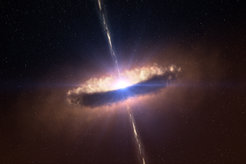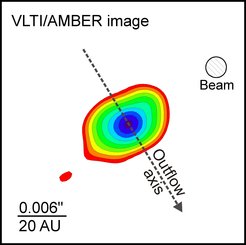A glimpse into a star's cradle
Max Planck researchers use interferometric observations to reveal the mysterious birth of massive stars
Stars are born in disks of matter. The details of this cosmic birth are still clouded in mystery, however. A team of astronomers headed by Stefan Kraus and comprising members of two research groups at the Max Planck Institute for Radio Astronomy in Bonn have now obtained the first infrared image of one of these compact disks around a massive young star. The very detailed image shows that such "heavyweights" form in the same way as their lower mass cousins. (Nature, July 15, 2010)

The astronomers selected a celestial object at a distance of 10,000 light years or so with the designation IRAS 13481-6124. The object is around twenty times the mass of our Sun and five times its diameter. "Our observations show a disk encircling a very young, massive star, which is nevertheless fully formed," says Stefan Kraus, who heads the research project. "The star is still in its embryonic stage, but its birth is imminent!"
The discovery was made possible by combining observations from three instruments in Chile: The APEX telescope on Chajnantor at an altitude of more than 5,000 metres and two telescopes at the European Southern Observatory: The Very Large Telescope Interferometer and the New Technology Telescope. Moreover, the scientists combined their observations with archive data from the Spitzer Space Telescope and discovered the presence of a bipolar jet.
"Such jets ejected from young stars generally indicate the presence of a circumstellar disc," says Karl Menten, Director at the Max Planck Institute for Radio Astronomy. It appears that the jet ejects matter at right angles to the disk. "Our project brings together the know-how of two groups of experts at the Institute, infrared interferometry to investigate the structure of the disk and submillimetre astronomy to investigate the bipolar outflow at very short radio wavelengths."
Disks of gas and dust are essential components in the formation of low-mass stars such as our Sun. However, it was unclear until now whether they also have a role to play in the formation of stars with a mass of more than ten solar masses. Their strong luminosity might prevent additional matter falling onto the star and thus prevent the mass from increasing further in the embryonic phase. The researchers therefore discussed another scenario and proposed that such massive stars could form when stars with lower mass merge.

Astronomers used the Very Large Telescope Interferometer at the European Southern Observatory (ESO), among others, to discover these disks, which also represent a reservoir from which planets can form, and investigate their properties. By combining the light from three 1.8-metre mirror telescopes, astronomers can see details equivalent to those one single 85-metre telescope would show. The resulting resolution of 2.4 milliarcseconds corresponds to the angular diameter of the head of a single screw on the International Space Station (ISS) when viewed from the ground.
"The first image of the inner disk encircling a young star enables us to study the physical connection between disks and outflows in such objects," says Gerd Weigelt, who is also a Director at the Max Planck Institute for Radio Astronomy. "The new observations suggest that the disks play an equally important role in the formation process of both low-mass and high-mass stars."
The astronomers conclude from their observations that the IRAS 13481-6124 system is about 60,000 years old, and that the star has already reached its final mass. The disk encircling the star will soon start to dissolve and maybe form a planetary system. It extends up to 130 times the Earth-Sun distance.
**************
The Atacama Pathfinder Experiment (APEX) is a 12-metre submillimetre telescope located at 5,100 m altitude on the Chajnantor plateau in the Chilean Andes. APEX operates at millimetre and submillimetre wavelengths. This wavelength range is still a relatively unexplored frontier in astronomy, requiring special detectors and extremely high and dry observatory sites. APEX is the largest submillimetre-wave telescope in the southern hemisphere and is operated as a collaboration between the Max Planck Institute for Radio Astronomy, the Swedish Onsala Observatory and the European Southern Observatory (ESO).
The ESO’s Very Large Telescope Interferometer (VLTI) at Cerro Paranal in Chile comprises four telescopes each with an 8.2-metre mirror diameter and four instruments each 1.8 metre in diameter. One of the scientific instruments at the VLTI is the Astronomical Multi-Beam Recombiner (AMBER ), an interferometric instrument which combines the beams of three individual telescopes and operates in the near-infrared wavelength range between 1 and 2.5 micrometres (one thousandth of a millimetre). It was built in collaboration with the Laboratoire d'Astrophysique de Grenoble, the Laboratoire d'Astrophysique Universitaire de Nice and Observatoire de la Côte d'Azur, as well as the Observatorio Astrofisico di Arcetri in Florence and the Max Planck Institute for Radio Astronomy, Bonn.

